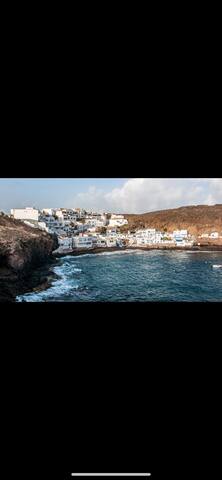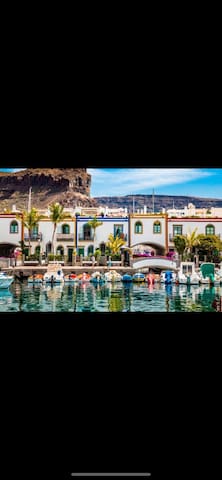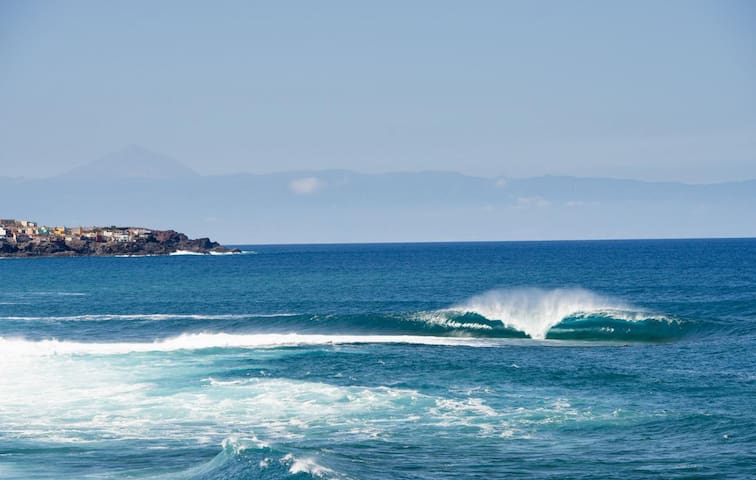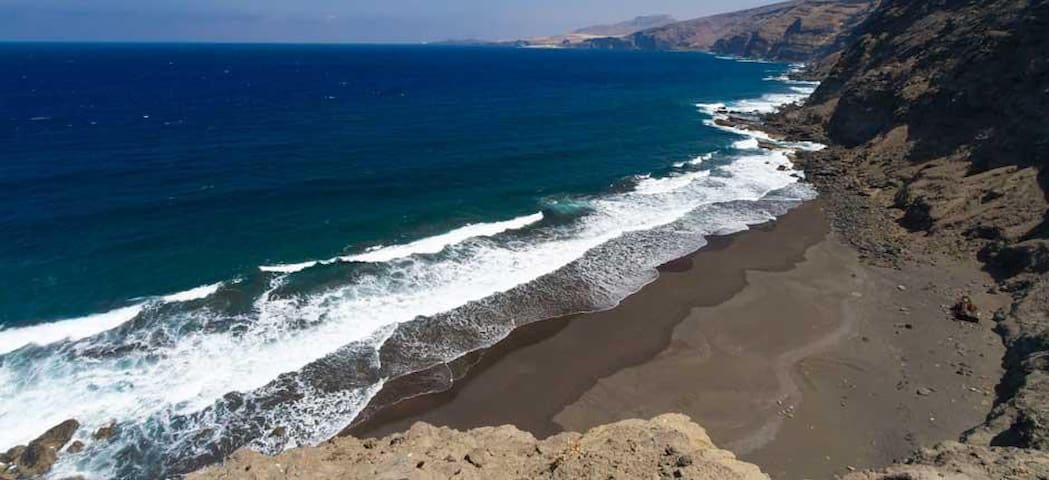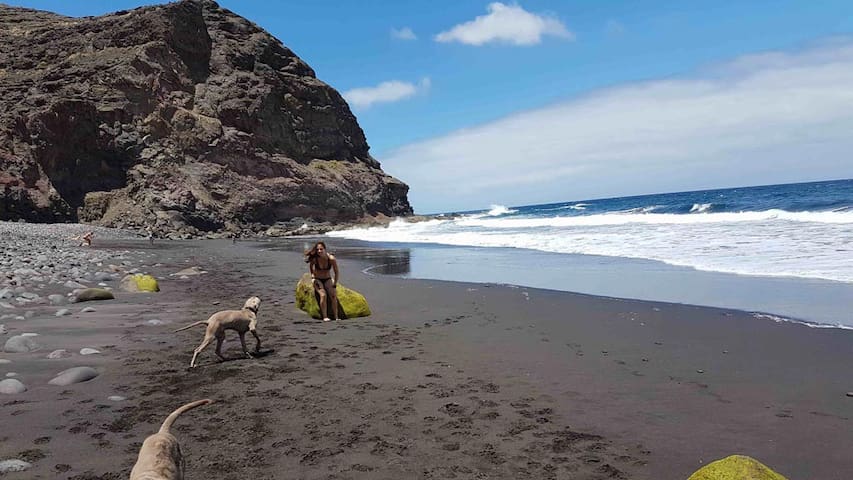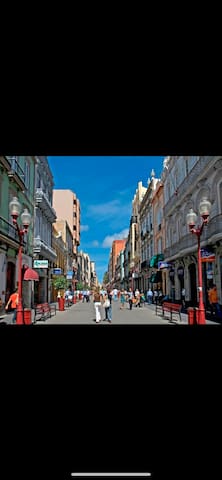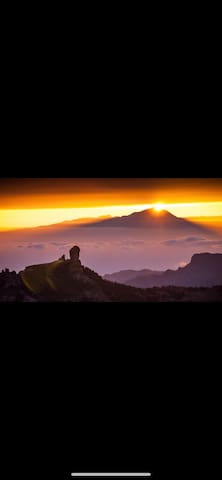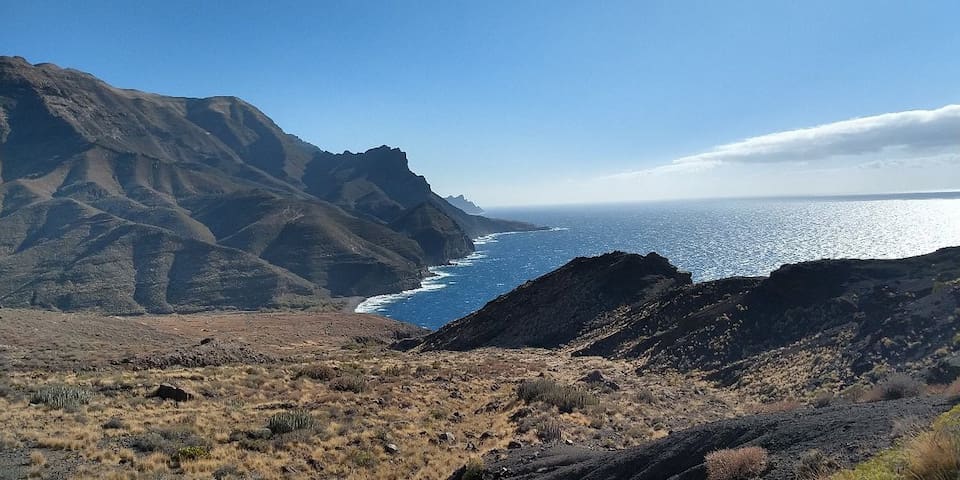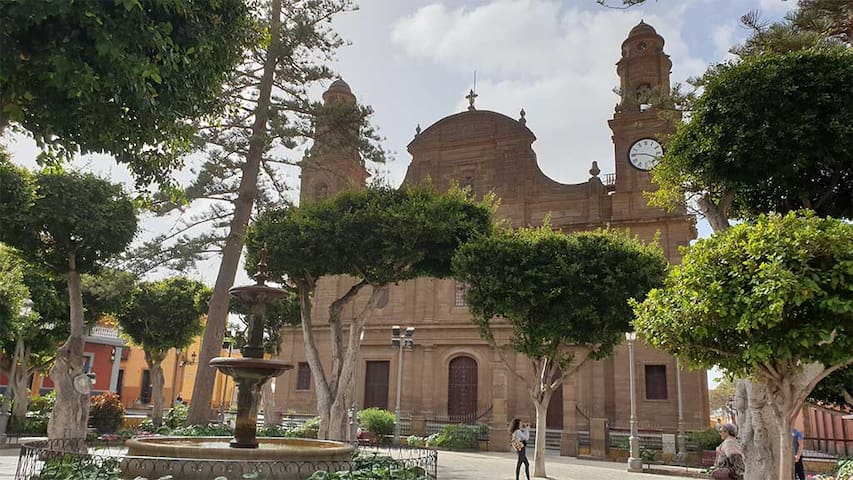BEACHES
One of the top Urban Beaches in Europe
Las Canteras beach in northeast Gran Canaria, right in the capital city Las Palmas, is amongst Europe’s most famous city beaches. It’s appeal is due to its natural beauty, city-centre location and the services and amenities along its promenade. At Las Canteras beach you get calm waters and warm weather all year round: Its natural offshore lava reef acts as a wavebreak and protects the sand and the exuberant marine life that make Las Canteras a top snorkeling spot.
A golden sand beach in Las Palmas de Gran Canaria
Las Canteras is an ideal beach for long barefoot walks as it’s golden sand stretches for over two kilometres. during the day you can sunbathe by the sand sculptures, rent parasols and loungers or surf at the southern end. Children love Las Canteras thanks to its clear, calm waters, playgrounds and sports zones. The beach is also accessible to all and has parking, changing rooms and showers. At sunset its beachfront terraces fill up and the promenade’s cafés, bars and restaurants are lively into the night.
467 persone del luogo consigliano
Spiaggia di Las Canteras
One of the top Urban Beaches in Europe
Las Canteras beach in northeast Gran Canaria, right in the capital city Las Palmas, is amongst Europe’s most famous city beaches. It’s appeal is due to its natural beauty, city-centre location and the services and amenities along its promenade. At Las Canteras beach you get calm waters and warm weather all year round: Its natural offshore lava reef acts as a wavebreak and protects the sand and the exuberant marine life that make Las Canteras a top snorkeling spot.
A golden sand beach in Las Palmas de Gran Canaria
Las Canteras is an ideal beach for long barefoot walks as it’s golden sand stretches for over two kilometres. during the day you can sunbathe by the sand sculptures, rent parasols and loungers or surf at the southern end. Children love Las Canteras thanks to its clear, calm waters, playgrounds and sports zones. The beach is also accessible to all and has parking, changing rooms and showers. At sunset its beachfront terraces fill up and the promenade’s cafés, bars and restaurants are lively into the night.
The Anfi del Mar beach is a white sand beach outside input Gran Canaria, crystal clear waters and little waves by breakwaters have been installed. It is a joy in every sense, ideal to spend the day with friends, and having no wave is nothing dangerous. It can be accessed by an elevator and well on a road that has the complex. Besides having good services and even a supermarket to buy drinks and food last hour.
109 persone del luogo consigliano
Anfi Del Mar
s/n Barranco de la VergaThe Anfi del Mar beach is a white sand beach outside input Gran Canaria, crystal clear waters and little waves by breakwaters have been installed. It is a joy in every sense, ideal to spend the day with friends, and having no wave is nothing dangerous. It can be accessed by an elevator and well on a road that has the complex. Besides having good services and even a supermarket to buy drinks and food last hour.
The Maspalomas Dune system is a unique wild place in the Canary Islands due to its beauty and range of ecosystems. Its 400 hectares, protected by the Canarian government as a Nature Reserve of special value, include a fantastic beach, a dynamic sand dune system, palm grove and a brackish lagoon. This mix of desert and oasis is at the southern tip of Gran Canaria and is surrounded by the famous Maspalomas resort.
322 persone del luogo consigliano
Riserva naturale delle dune di Maspalomas
The Maspalomas Dune system is a unique wild place in the Canary Islands due to its beauty and range of ecosystems. Its 400 hectares, protected by the Canarian government as a Nature Reserve of special value, include a fantastic beach, a dynamic sand dune system, palm grove and a brackish lagoon. This mix of desert and oasis is at the southern tip of Gran Canaria and is surrounded by the famous Maspalomas resort.
Gui-gui can really be called a secret beach. It is very beautiful, absolutely virgin and not spoiled by tourists. The beach is located in the southwest of the Gran-Canaria island between two mountains.
It is so untouched by civilization that there is not only no infrastructure (only a hose with drinking water), but there is no even a telephone connection.
To get there, you need to overcome a mountain pass. Round trip hiking in total is 15 km. 2 hours one-way. An hour uphill and an hour downhill.
39 persone del luogo consigliano
Playa de Güi-Güi - Chico
Gui-gui can really be called a secret beach. It is very beautiful, absolutely virgin and not spoiled by tourists. The beach is located in the southwest of the Gran-Canaria island between two mountains.
It is so untouched by civilization that there is not only no infrastructure (only a hose with drinking water), but there is no even a telephone connection.
To get there, you need to overcome a mountain pass. Round trip hiking in total is 15 km. 2 hours one-way. An hour uphill and an hour downhill.
Long time ago they built these houses almost by the sea, nowadays this would be unthinkable. Despite of this, Tufia is a very authentic place and it is not a tourist site. Its white houses with blue touches, so as the cave houses and sea figures makes Tufia a special and different place.
You should know that the beach Tufia is considered Site of Scientific Interest due to its singularity.
Historical fact; the electricity came into this town in 1997.
23 persone del luogo consigliano
Tufia
Long time ago they built these houses almost by the sea, nowadays this would be unthinkable. Despite of this, Tufia is a very authentic place and it is not a tourist site. Its white houses with blue touches, so as the cave houses and sea figures makes Tufia a special and different place.
You should know that the beach Tufia is considered Site of Scientific Interest due to its singularity.
Historical fact; the electricity came into this town in 1997.
The port town of Agaete, on the north-west coast of the island of Gran Canaria, is not your average resort town. Steeped in history, Agaete’s origins date back to even before the Spanish Christian conquerors disembarked on the island in the 15th century. Its ancestral roots are just as old as the neighbouring ancient burial site of Maipés necropolis, one of the most important archaeological sites on the island.
Mingle with the hospitable and friendly chanos, the name given to Gran Canaria islanders, as you wander the picturesque streets lined with dazzling whitewashed houses and wrapped in the sultry smell of coffee coming out of inviting coffee shops and restaurants.
Situated just 32 km north from Las Palmas, Agaete is nestled in a dramatic natural setting, surrounded by lush meadows and plunging volcanic rock cliffs. Read on to discover the best this tiny enclave has to offer.
What to see in Agaete
Get your walking shoes ready because the best way to explore the town is by foot! Start at the town’s central square, Plaza de la Constitución and admire the town’s lovely main church, Iglesia de la Concepción. It only dates back to 1875, but actually stands on the site where a much older church once stood before being burnt down in a devastating fire.
29 persone del luogo consigliano
Agaete - Puerto de Las Nieves station
The port town of Agaete, on the north-west coast of the island of Gran Canaria, is not your average resort town. Steeped in history, Agaete’s origins date back to even before the Spanish Christian conquerors disembarked on the island in the 15th century. Its ancestral roots are just as old as the neighbouring ancient burial site of Maipés necropolis, one of the most important archaeological sites on the island.
Mingle with the hospitable and friendly chanos, the name given to Gran Canaria islanders, as you wander the picturesque streets lined with dazzling whitewashed houses and wrapped in the sultry smell of coffee coming out of inviting coffee shops and restaurants.
Situated just 32 km north from Las Palmas, Agaete is nestled in a dramatic natural setting, surrounded by lush meadows and plunging volcanic rock cliffs. Read on to discover the best this tiny enclave has to offer.
What to see in Agaete
Get your walking shoes ready because the best way to explore the town is by foot! Start at the town’s central square, Plaza de la Constitución and admire the town’s lovely main church, Iglesia de la Concepción. It only dates back to 1875, but actually stands on the site where a much older church once stood before being burnt down in a devastating fire.
hree natural swimming pools are sheltered from the open ocean by concrete protective columns that resemble a castle. The pools are linked by volcanic tubes and boasts spectacular views of Mount Teide, rising over the Atlantic Ocean. This is a great destination for the entire family and the site is equipped with a series of amenities, such as: a sun terrace, a restaurant and parking. You can either take a leisurely walk from the port to reach Las Salinas or make the 5-minute drive.
44 persone del luogo consigliano
Piscina naturale di Agaete
17 C. el Muellehree natural swimming pools are sheltered from the open ocean by concrete protective columns that resemble a castle. The pools are linked by volcanic tubes and boasts spectacular views of Mount Teide, rising over the Atlantic Ocean. This is a great destination for the entire family and the site is equipped with a series of amenities, such as: a sun terrace, a restaurant and parking. You can either take a leisurely walk from the port to reach Las Salinas or make the 5-minute drive.
Playa del Inglés beach is one of Gran Canaria’s most famous resort beaches. Located in south Gran Canaria its almost three kilometres of golden sand and calm waters are next to the Maspalomas dunes Nature Reserve and close to a wide range of accommodation options. Along the beach you find service areas and places for sports such as volleyball and beach football. An ideal location to spend a day on the beach.
288 persone del luogo consigliano
Playa del Inglés
23 Paseo Costa CanariaPlaya del Inglés beach is one of Gran Canaria’s most famous resort beaches. Located in south Gran Canaria its almost three kilometres of golden sand and calm waters are next to the Maspalomas dunes Nature Reserve and close to a wide range of accommodation options. Along the beach you find service areas and places for sports such as volleyball and beach football. An ideal location to spend a day on the beach.
Very nice beach where you can camping, put a tent and sleep under the stars! The beach is closed by natural mountains and entrance there is quite problematic, but not impossible
8 persone del luogo consigliano
Playa Nudista Montana Arena
Very nice beach where you can camping, put a tent and sleep under the stars! The beach is closed by natural mountains and entrance there is quite problematic, but not impossible
Beautiful area and lovely sea front bars and restaurants. Gorgeous flowers down the narrow streets. you gotta visit The Mirador viewpoint during the sunset
84 persone del luogo consigliano
Puerto de Mogán
Beautiful area and lovely sea front bars and restaurants. Gorgeous flowers down the narrow streets. you gotta visit The Mirador viewpoint during the sunset
One of the world’s best bodyboard waves in Gran Canaria
The El Frontón spot on the north east coast of Gran Canaria is one of the world’s best bodyboarding breaks and was chosen by bodyboard pros as the fifth best wave in the world. Access is via the seaside village of Caleta de Arriba and through a labyrinth of banana plantations, followed by a steep but walkable cliff. You can park right by the break or walk in from nearby Agujero beach but caution is required due to the constant pounding surf in the area.
A spot for radical maneuvers close to Caleta de Arriba
El Frontón is so powerful that it’s often compared to Teahupoo. When the wave breaks over the lava bottom it forms a powerful tube that breaks left and right. It requires experience and guts on big days but rewards you with the chance to do jumps and radical maneuvers. Access to the break is relatively simple as you can walk out to the edge of the reef, watching out for waves. El Frontón is consistent throughout the year at high tide and SE- SW-E winds and W-NW-N-SW swell but the biggest waves roll in between October and May
El Frontón
One of the world’s best bodyboard waves in Gran Canaria
The El Frontón spot on the north east coast of Gran Canaria is one of the world’s best bodyboarding breaks and was chosen by bodyboard pros as the fifth best wave in the world. Access is via the seaside village of Caleta de Arriba and through a labyrinth of banana plantations, followed by a steep but walkable cliff. You can park right by the break or walk in from nearby Agujero beach but caution is required due to the constant pounding surf in the area.
A spot for radical maneuvers close to Caleta de Arriba
El Frontón is so powerful that it’s often compared to Teahupoo. When the wave breaks over the lava bottom it forms a powerful tube that breaks left and right. It requires experience and guts on big days but rewards you with the chance to do jumps and radical maneuvers. Access to the break is relatively simple as you can walk out to the edge of the reef, watching out for waves. El Frontón is consistent throughout the year at high tide and SE- SW-E winds and W-NW-N-SW swell but the biggest waves roll in between October and May
Great place to walk along the ocean away from Las Canteras to a remote beach that is beautiful in its own way. You can walk for several kilometres and see beautiful vistas along the way. Take a camera!
El confital, Las Palmas, Spagna
Great place to walk along the ocean away from Las Canteras to a remote beach that is beautiful in its own way. You can walk for several kilometres and see beautiful vistas along the way. Take a camera!
La Cícer (Playa de Las Canteras)
surf spot in Las Palmas
HIDDEN BEACHES
An unspoiled beach ideal for hiking enthusiasts
Faneroque Beach is located in the northwest of Gran Canaria, very close to Agaete. The tranquility of this privileged corner, far from urbanized areas, captivates many nature lovers. In addition, the small beach of Faneroque, which remains practically virgin, can only be reached on foot, making it an ideal place to end a day of hiking with a dip in the sea
Playa de Faneroque
An unspoiled beach ideal for hiking enthusiasts
Faneroque Beach is located in the northwest of Gran Canaria, very close to Agaete. The tranquility of this privileged corner, far from urbanized areas, captivates many nature lovers. In addition, the small beach of Faneroque, which remains practically virgin, can only be reached on foot, making it an ideal place to end a day of hiking with a dip in the sea
The beach of El Risco is located in the municipality of Agaete in the northwest side of Gran Canaria. It is a virgin beach of round stones and black sand. As you can see below, the beach is very quiet and there are usually no people. We even went with our dogs. However, on this beach there is no lifeguard. Therefore, we do not recommend that you venture much in case the current plays a trick on you. You do not have any services around either, so whatever you need, take it with you and enjoy it!
El Risco
El RiscoThe beach of El Risco is located in the municipality of Agaete in the northwest side of Gran Canaria. It is a virgin beach of round stones and black sand. As you can see below, the beach is very quiet and there are usually no people. We even went with our dogs. However, on this beach there is no lifeguard. Therefore, we do not recommend that you venture much in case the current plays a trick on you. You do not have any services around either, so whatever you need, take it with you and enjoy it!
NEIGHBORHOODS GUIDE
From the northern end of the district of Playa de las Canteras, you’re within walking distance of the old fishermen’s quarter of La Isleta, situated on a small peninsula.
Built on steep terrain, La Isleta features narrow streets with many street vendors, old small shops, bars and an important Spanish naval base. The centre of this district forms the Plaza Ingeniero Manuel Becerra, a lively square, which is bordered by a lighthouse on one side and by the harbour gate on the other.
15 persone del luogo consigliano
La Isleta
27 C. FaroFrom the northern end of the district of Playa de las Canteras, you’re within walking distance of the old fishermen’s quarter of La Isleta, situated on a small peninsula.
Built on steep terrain, La Isleta features narrow streets with many street vendors, old small shops, bars and an important Spanish naval base. The centre of this district forms the Plaza Ingeniero Manuel Becerra, a lively square, which is bordered by a lighthouse on one side and by the harbour gate on the other.
The most interesting sights to see: Only a few metres away from the site of the military encampment, from which the first settlement originated, you will find the Plaza Santa Ana with its entrance guarded by bronze statues of dogs symbolising the legendary canine, which since 1506 was said to have appeared in the town’s heights, and some impressive historic buildings, of which many have survived in their original state up to date.
Noteworthy among these magnificent buildings are the Casa Regental, a largely 17th-century building serving as residence of the president of Gran Canaria’s High Court of Law, the elegant 19th-century building of the Casas Consistoriales (Town Hall) and the Palacio Episcopal (Bishop’s Palace), of which only an ornate single-storey façade remained after the great fire of 1599, and the imposing Catedral de Santa Ana.
Staying in the Vegueta district, on Calle del Doctor Chil, you’ll find the Church of the old Augustinian Convent, where the High Court sits today, the baroque Church of San Francisco de Asís, the sombre-looking Old Seminary and, last but not least, the Museo Canario (Canary Island Museum) at the corner of Calle Doctor Verneau.
Just around the corner from the Museo Canario is the Plaza del Espíritu Santo (Square of the Holy Spirit), a charming square with an impressive monumental fountain located in its centre, surrounded by a number of stately historical houses and the Chapel of the Holy Spirit. This is well worth a visit.
La Vegueta
The most interesting sights to see: Only a few metres away from the site of the military encampment, from which the first settlement originated, you will find the Plaza Santa Ana with its entrance guarded by bronze statues of dogs symbolising the legendary canine, which since 1506 was said to have appeared in the town’s heights, and some impressive historic buildings, of which many have survived in their original state up to date.
Noteworthy among these magnificent buildings are the Casa Regental, a largely 17th-century building serving as residence of the president of Gran Canaria’s High Court of Law, the elegant 19th-century building of the Casas Consistoriales (Town Hall) and the Palacio Episcopal (Bishop’s Palace), of which only an ornate single-storey façade remained after the great fire of 1599, and the imposing Catedral de Santa Ana.
Staying in the Vegueta district, on Calle del Doctor Chil, you’ll find the Church of the old Augustinian Convent, where the High Court sits today, the baroque Church of San Francisco de Asís, the sombre-looking Old Seminary and, last but not least, the Museo Canario (Canary Island Museum) at the corner of Calle Doctor Verneau.
Just around the corner from the Museo Canario is the Plaza del Espíritu Santo (Square of the Holy Spirit), a charming square with an impressive monumental fountain located in its centre, surrounded by a number of stately historical houses and the Chapel of the Holy Spirit. This is well worth a visit.
Many of the buildings along this street are real gems. All of them with their own personality and clad in contrasting clear colours. Even so, the general impression is very harmonious. Do not let all attractive shopping windows make you forget to admire the facades.
Triana
Many of the buildings along this street are real gems. All of them with their own personality and clad in contrasting clear colours. Even so, the general impression is very harmonious. Do not let all attractive shopping windows make you forget to admire the facades.
SUNSET SPOTS
I recommend you to go for the sunset it's the best place to be. Above the clouds, This is obviously a must-do
452 persone del luogo consigliano
Roque Nublo
I recommend you to go for the sunset it's the best place to be. Above the clouds, This is obviously a must-do
The Punta Sardina Lighthouse (Spanish: Faro de Punta Sardina) is an active lighthouse on the Canary island of Gran Canaria. It is located north of the small town of Sardina, in the municipality of Gáldar.[1] The Punta Sardina light marks the north-western extremity of the island, and lies between the Punta del Castillete lighthouse near Puerto de Mogán to the south and the La Isleta lighthouse of Las Palmas to the east.
great to go for a sunset.
8 persone del luogo consigliano
Faro di Punta Sardina
10C Urbanización Sau-Playa CanariaThe Punta Sardina Lighthouse (Spanish: Faro de Punta Sardina) is an active lighthouse on the Canary island of Gran Canaria. It is located north of the small town of Sardina, in the municipality of Gáldar.[1] The Punta Sardina light marks the north-western extremity of the island, and lies between the Punta del Castillete lighthouse near Puerto de Mogán to the south and the La Isleta lighthouse of Las Palmas to the east.
great to go for a sunset.
Pico de las Nieves is the second highest peak on the island of Gran Canaria, Canary Islands, Spain. Its height is 1,949 metres (6,394 ft) above sea level. Great sunset spot
147 persone del luogo consigliano
Pico de las Nieves
Pico de las Nieves is the second highest peak on the island of Gran Canaria, Canary Islands, Spain. Its height is 1,949 metres (6,394 ft) above sea level. Great sunset spot
Stunning, Amazing, must be done while in Gran Canaria. That place makes you realise the greatness of nature
13 persone del luogo consigliano
Mirador del Balcon
Stunning, Amazing, must be done while in Gran Canaria. That place makes you realise the greatness of nature
LAKE
a very enticing place to visit, with pine trees, goats and crystal clear water. all the roads that lead there are pure bliss for car enthusiasts.
41 persone del luogo consigliano
Presa de Las Ninas
a very enticing place to visit, with pine trees, goats and crystal clear water. all the roads that lead there are pure bliss for car enthusiasts.
PARKS
This park is located between the harbour Puerto de la Luz and the beach Las Canteras.
The square with palm trees and flowerbeds is a popular nightlife spot. There are numerous restaurants, bars, clubs and discos.
At carnival time a big stage is erected here and the park becomes the centre of the city’s colourful celebrations. Also, the popular WOMAD music festival in November is held here.
During the daytime, people are doing their shopping and visiting numerous outdoor cafes. Elderly men are playing cards, chess and dominos.
The tourist information point is located here. On the port side you will find the Museo Elder de la Ciencia y la Tecnologia, a science and technology museum
109 persone del luogo consigliano
Parque Santa Catalina station
This park is located between the harbour Puerto de la Luz and the beach Las Canteras.
The square with palm trees and flowerbeds is a popular nightlife spot. There are numerous restaurants, bars, clubs and discos.
At carnival time a big stage is erected here and the park becomes the centre of the city’s colourful celebrations. Also, the popular WOMAD music festival in November is held here.
During the daytime, people are doing their shopping and visiting numerous outdoor cafes. Elderly men are playing cards, chess and dominos.
The tourist information point is located here. On the port side you will find the Museo Elder de la Ciencia y la Tecnologia, a science and technology museum
Nice park with a little church, the first built in Las Palmas, a super decorated pavilion with coffee shop, etc. Good for a little pause after having strolled in the beautiful old parts of the town.
31 persone del luogo consigliano
Parque San Telmo
30 Av. Rafael CabreraNice park with a little church, the first built in Las Palmas, a super decorated pavilion with coffee shop, etc. Good for a little pause after having strolled in the beautiful old parts of the town.
Located on the southern coast of La Isleta, the Castillo de la Luz (Castle of Light) defended the natural harbour of Las Palmas de Gran Canaria for several centuries. Built in 1494 on top of the foundations of an existing fort from the time of the conquest by the Castilians, this solid square-shaped fortress, which was equipped with a platform for 11 cannons, nevertheless suffered severe damages during the invasion of Dutch pirates in 1599 when it was more or less burned to the ground.
Since then the two-storey building has been rebuilt, extended and improved. Indeed, in 1941 the Castillo de la Luz was declared a national historic monument. This well-preserved fortress was further restored in 1998 and serves today as a cultural and exhibition centre for national and international events.
Parque del Castillo de la Luz
13 C. GordilloLocated on the southern coast of La Isleta, the Castillo de la Luz (Castle of Light) defended the natural harbour of Las Palmas de Gran Canaria for several centuries. Built in 1494 on top of the foundations of an existing fort from the time of the conquest by the Castilians, this solid square-shaped fortress, which was equipped with a platform for 11 cannons, nevertheless suffered severe damages during the invasion of Dutch pirates in 1599 when it was more or less burned to the ground.
Since then the two-storey building has been rebuilt, extended and improved. Indeed, in 1941 the Castillo de la Luz was declared a national historic monument. This well-preserved fortress was further restored in 1998 and serves today as a cultural and exhibition centre for national and international events.
Parque Romano
270 Terracera Leon y Castillofree gym equipment and 1 km park to run
The Tamadaba Natural Park is one of Gran Canaria’s most pristine areas. Its 7,500 hectares stretch from the highlands down to the coast in the fast west of the island within the Unesco Biosphere Reserve. You can choose between forests of indigenous Canary pine trees, the steep, almost inaccessible, cliffs of the west coast and the rich biodiversity of its valleys.
115 persone del luogo consigliano
Parco Naturale di Tamadaba
The Tamadaba Natural Park is one of Gran Canaria’s most pristine areas. Its 7,500 hectares stretch from the highlands down to the coast in the fast west of the island within the Unesco Biosphere Reserve. You can choose between forests of indigenous Canary pine trees, the steep, almost inaccessible, cliffs of the west coast and the rich biodiversity of its valleys.
The jardín botanico (botanical garden) is located in Tafira, a suburb of Las Palmas lying in a fecund valley above the capital city of the Canaries. Within a few hours the whole variety of the Canaries‘ botanic can be explored and accessorily even admired - and all for free!
156 persone del luogo consigliano
Giardino Botanico Canario Viera y Clavijo
The jardín botanico (botanical garden) is located in Tafira, a suburb of Las Palmas lying in a fecund valley above the capital city of the Canaries. Within a few hours the whole variety of the Canaries‘ botanic can be explored and accessorily even admired - and all for free!
HIKES
here is a well guarded and little-known secret to the west of Gran Canaria, where hectic hustle and bustle can be calmed down with a relaxing bathe in a fresh water pool. This place is called El Charco Azul.
You can reach this spot from the village of El Risco, some 49 kilometres from Las Palmas and just 14 kilometres from Agaete. El Risco is a tiny hamlet with around 300 inhabitants, behind which is one of the finest hybrid treasures on the island. It is one of those spots for those looking for more unconventional natural attractions.
Many day-trippers who rush past this tiny village can easily make the mistake of overlooking El Risco. It is easy to see it as a simple place to stop off at for a quick drink and a breather on your way around the winding main road.
However, there is much more to this place than meets the eye. Firstly, you will be pleasantly surprised by the traditional family welcome you will receive from the locals. Then after this you will find yourself in a stunning piece of countryside that seems to draw you in and keep you walking on and on.
As we make our way through the ever changing daytime colours of the ravine, we are treated to a gorgeous spectacle. We can cast our eyes over the hillsides of the ravine, with agricultural plots that are dotted about with Canary palm trees and pools. And we are on our way to one very special pool here. This is the final destination of our ramble. After around half an hour’s walk we come to the Charco Azul.
17 persone del luogo consigliano
El Charco Azul
here is a well guarded and little-known secret to the west of Gran Canaria, where hectic hustle and bustle can be calmed down with a relaxing bathe in a fresh water pool. This place is called El Charco Azul.
You can reach this spot from the village of El Risco, some 49 kilometres from Las Palmas and just 14 kilometres from Agaete. El Risco is a tiny hamlet with around 300 inhabitants, behind which is one of the finest hybrid treasures on the island. It is one of those spots for those looking for more unconventional natural attractions.
Many day-trippers who rush past this tiny village can easily make the mistake of overlooking El Risco. It is easy to see it as a simple place to stop off at for a quick drink and a breather on your way around the winding main road.
However, there is much more to this place than meets the eye. Firstly, you will be pleasantly surprised by the traditional family welcome you will receive from the locals. Then after this you will find yourself in a stunning piece of countryside that seems to draw you in and keep you walking on and on.
As we make our way through the ever changing daytime colours of the ravine, we are treated to a gorgeous spectacle. We can cast our eyes over the hillsides of the ravine, with agricultural plots that are dotted about with Canary palm trees and pools. And we are on our way to one very special pool here. This is the final destination of our ramble. After around half an hour’s walk we come to the Charco Azul.
You will find La Fortaleza in the municipality of Santa Lucía de Tirajana, to the southeast of Gran Canaria, at the heart of Caldera de Las Tirajanas.
Who said stones don’t talk? Come along to La Fortaleza, listen carefully, and you will be able to count the endless numbers of colours that emerge from the mountains and skies. Then just a second later, you will start to appreciate the undulating terrain. And once you are at one with nature, you will see how you will soon stop feeling tiny in the presence of such enormity.
7 persone del luogo consigliano
La fortaleza de Ansite
GC-651You will find La Fortaleza in the municipality of Santa Lucía de Tirajana, to the southeast of Gran Canaria, at the heart of Caldera de Las Tirajanas.
Who said stones don’t talk? Come along to La Fortaleza, listen carefully, and you will be able to count the endless numbers of colours that emerge from the mountains and skies. Then just a second later, you will start to appreciate the undulating terrain. And once you are at one with nature, you will see how you will soon stop feeling tiny in the presence of such enormity.
The range of colours on display is really quite something. Yes it can be seen from a few miles away but it's well worth getting close up to it of possible. There are parking areas off the road alongside but I'd imagine that often they get busy. If possible tough, park up and take a mini-hike up the rocks for a short while to get a closer and better look.
7 persone del luogo consigliano
Le piastrelle blu di Veneguera (Rainbow Rocks)
GC-200The range of colours on display is really quite something. Yes it can be seen from a few miles away but it's well worth getting close up to it of possible. There are parking areas off the road alongside but I'd imagine that often they get busy. If possible tough, park up and take a mini-hike up the rocks for a short while to get a closer and better look.
Barranco de Guayedra is a gorge located in the GC-200, a road that joins La Aldea de San Nicolás and Agaete, in the West region of Gran Canaria Island. It is one of the wonderful stops on the road. In fact, from here you can see the union between volcanic land and the ocean.
7 persone del luogo consigliano
Barranco de Guayedra
Barranco de Guayedra is a gorge located in the GC-200, a road that joins La Aldea de San Nicolás and Agaete, in the West region of Gran Canaria Island. It is one of the wonderful stops on the road. In fact, from here you can see the union between volcanic land and the ocean.
The Las Vacas ravine has become a well-known tourist attraction for residents and visitors of Gran Canaria. Why? For its peculiar rock formations called Tobas de Colores. These striking formations bear a certain resemblance to the famous Antelope Canyon of the United States. However, we are talking about a small area in the middle of the ravine. Also, as it is a very small trendy place, its enjoyment is getting complicated. Both for its overcrowding, as for the scarce parking in the area. We tell you everything below!
34 persone del luogo consigliano
Barranco de Las Vacas
The Las Vacas ravine has become a well-known tourist attraction for residents and visitors of Gran Canaria. Why? For its peculiar rock formations called Tobas de Colores. These striking formations bear a certain resemblance to the famous Antelope Canyon of the United States. However, we are talking about a small area in the middle of the ravine. Also, as it is a very small trendy place, its enjoyment is getting complicated. Both for its overcrowding, as for the scarce parking in the area. We tell you everything below!
The Way of St James of Gran Canaria (Camino de Santiago de Gran Canaria) is one of the hardest and most beautiful hiking routes and challenges in Gran Canaria. It is a 66-kilometer track that is recommended to be divided into three stages. This Jacobean route crosses the island from south to north. That is, from the Maspalomas Lighthouse to the town of Gáldar and its Church of Santiago.
Camino de Santiago
Camino de SantiagoThe Way of St James of Gran Canaria (Camino de Santiago de Gran Canaria) is one of the hardest and most beautiful hiking routes and challenges in Gran Canaria. It is a 66-kilometer track that is recommended to be divided into three stages. This Jacobean route crosses the island from south to north. That is, from the Maspalomas Lighthouse to the town of Gáldar and its Church of Santiago.
The Caldera de Bandama is one of the most unique natural spaces on Gran Canaria, and yet many of the tourists who holiday on the island each year don’t even know it exists. At just a short distance from the island’s capital Las Palmas, it’s well worth a visit, and not just to wonder at the immense geological forces that shaped it but to admire the scale of human adaptation to what is a complicated environment.
117 persone del luogo consigliano
Caldera de Bandama
The Caldera de Bandama is one of the most unique natural spaces on Gran Canaria, and yet many of the tourists who holiday on the island each year don’t even know it exists. At just a short distance from the island’s capital Las Palmas, it’s well worth a visit, and not just to wonder at the immense geological forces that shaped it but to admire the scale of human adaptation to what is a complicated environment.

